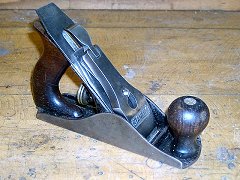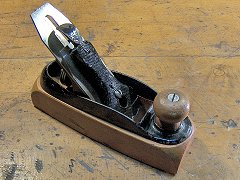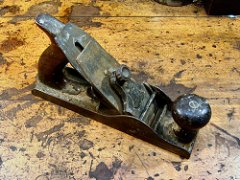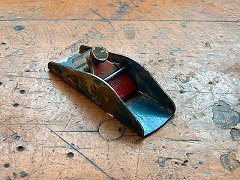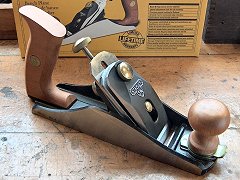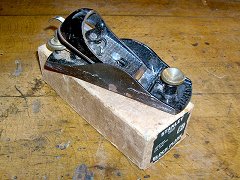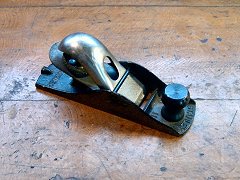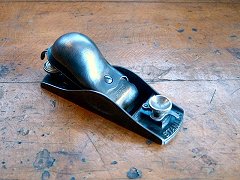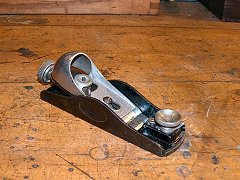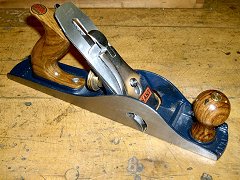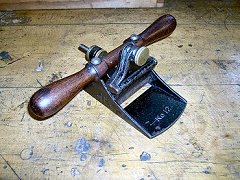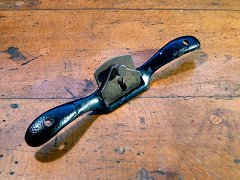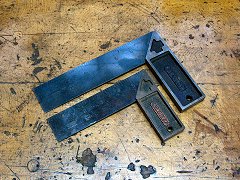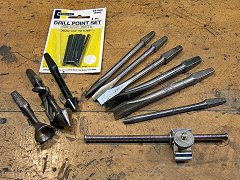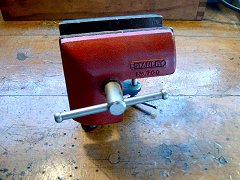Vintage Tool Gallery
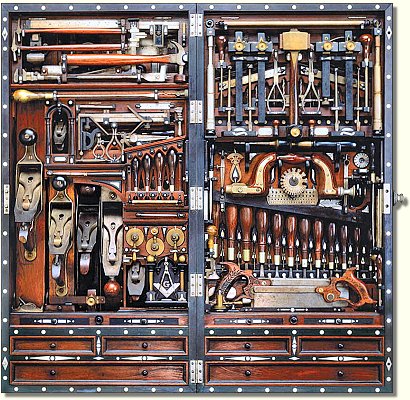
The Henry O. Studley tool chest of the late 19th century.
As the years have gone by while undertaking our massive home renovation, I've found myself purchasing more and more vintage hand tools to deal with certain projects. I started with a few hand planes to use for finish carpentry tasks, but then I'd find I could use a bevel gauge, small vise, or some other vintage tool to help move things along. I also started posting pictures of the tools I'd acquired along with some specifications about the date of manufacture. It didn't take long to realize I'd become a vintage tool collector, and I was spending a fair amount of time finding old bits of iron and steel that I wanted for the collection rather than because I needed them for a specific job. Tracking all of the information about these tools and posting photos of everything I have soon outgrew a single web page, so after putting it off for a few years I've finally decided to break up the vintage tool information into a number easier to handle individual pages.
The original Hand Planes page with all of the information regarding plane restoration and tuning has been shortened considerably and re-located into the new Et cetera section of the site. The old Vintage Hand Tool Data section of that page now stands on its own in the Specifications section. This page now contains all the photos of the vintage tools I own (that used to be on the Hand Planes page), and the photo sets have been broken up into smaller groups of photos to allow easier and faster browsing.
I've organized the sets of photos below to correspond to how I've categorized my collection on the Vintage Hand Tool Data listing. Hopefully you'll now be able to find a particular tool without difficulty, and without having to click through 30 or 40 images to get to the one you want to see.
Bench Planes
Included here are photos of all the hand planes and other vintage tools I currently own. These planes have all been purchased with the intention of putting them to use in the wood shop, and not just sitting them on a shelf in my office. I've attempted to properly "type" and date each of the planes to some extent, as noted in the photos. For planes where I cannot verify the date, I list the years Stanley produced that model as a general guideline to the possible age of the tool. All of these photos show the tools in the condition they were in when I received them (except the No. 45 plane, which has been rust-zapped and wire wheeled). The majority of planes I own are made by Stanley, and date from the late 30's. For the more common bench planes (3 through 6), I'm trying to get multiple versions of the same size so I can set them up differently, rather than have to tweak each plane whenever I require a different set-up. I like the idea of having a smooth-sole plane for coarse work, then a corrugated-sole plane with a chamfered iron for fine work.
There have been a few planes that I've been chasing for years (the No. 10 and No. 79, for example) and I always seem to get
out-bid in the last few minutes when trying to buy them on E-Bay. I've finally given up (on those two, at least),
and just purchased brand new units from Anant and Kunz. They're pretty awful, and will likely require more work than some
of my worst old Stanley planes to get tuned and working properly. Other new planes include the Stanley No. 9½ and 12-960 (which
is the same as a No. 60½), that I picked up a few years ago when I needed a functional block plane. Most recently Stanley
released a handful of new "Sweet Heart Premium" planes with heavy A2 steel cutters, a one piece sole and frog casting,
and an adjustable mouth. I picked up the No. 4 and No. 62, and find them surprisingly well made considering the cost
(especially compared to Veritas or Lie-Nielson's similar versions). Recently I've added the "Premium" versions of the
60½ and 92 to my user arsenal as well. Lately I've been relying more on the selections available each month through
Patrick Leach's e-mailed list of tools for sale through
The Superior Works![]() ,
rather than playin' with E-Bay. I've had good results getting some of the harder-to-find planes that I've been wanting for some time
from him, and the prices are certainly fair.
,
rather than playin' with E-Bay. I've had good results getting some of the harder-to-find planes that I've been wanting for some time
from him, and the prices are certainly fair.
Bailey Iron Bench Planes
Stanley bench planes, unless otherwise noted. Used for smoothing and surfacing of wood, and edge jointing preparation.
First offered by Stanley in 1870 after their acquisition of the production license for Bailey's seven plane patents in 1869,
the most important of which were the 8/31/1858 cammed lever cap and the 8/6/1867 cutter adjustment, still manufactured today.
Stanley retained Bailey's numbering system for iron bench planes No. 1 through No. 8, adding corrugated bottom availability
for sizes No. 2 through No. 8 in 1898 (designated by the letter "C" in catalogs but not in the plane's casting).
Later changes in model number include the addition of the wider No. 4½ in 1884 and 5½ in 1898, as well as an
extra-heavy version of the No. 4½ and 5½ in 1902, designated by the letter "H" in the casting (but never
offered in catalogs as such). The final addition to the line was in 1921, with the introduction of a smaller, lighter Jack
plane No. 5¼.
Wood-Bottom "Transitional" Bench Planes
Wood-bottom Stanley bench planes offered as an option for users hesitant to make the change from the traditional
wood-with-wedged-blade plane to the new Bailey patented blade adjustment mechanism, while maintaining the look and
feel of the wooden plane (hence the term "transitional"). Bailey had been manufacturing bench planes in Boston from
1858 until 1869 when he made the deal with Stanley, with both iron and wood-bottom models available. Bailey's
original "transitional" models were numbered 1 through 14, which Stanley changed to 21 through 34 by adding the prefix 2 for
size 1 through 9, and 3 for sizes 10 through 14 when they took over production. Stanley also added the No. 35 through No. 37 sizes with a rear
handle and a modified, stepped-down casting to allow room for the adjustment mechanism. In 1898 Stanley made one addition
to the "transitional" line with a wider version of the No. 27, designated as the No. 27½. Most "transitional"
model production was ended by 1917 as iron bench planes took over sales, but a few popular models lasted until as late
as 1943 before they were discontinued.
"Liberty Bell" Bench Planes
In addition to the planes based on Bailey's patents, Stanley also offered their own line of planes based on Traut
& Richards 1875 patented cutter adjustment and lever cap (which were much cheaper and simpler to produce than Bailey's
design). Introduced in 1876 with a Liberty Bell inscribed with the number "76" in it cast on the lever cap to
celebrate the nation's centennial, the "Liberty Bell" line remained in production until 1918. Five wood-bottom
"Liberty Bell" models were produced in identical sizes to their Bailey patented counterparts, designated as
models No. 122, 127, 129, 132, and the stepped-down handle 135 (as well as two steel models No. 104 and No. 105).
"Handyman" Planes
Lesser quality Stanley planes marketed for occasional home use. I first became enamored with planes thanks to my father's
H1204 Handyman plane, so despite many collectors frowning upon this line of Stanley planes, I've made some effort to collect
all nine of the Handyman plane models. The Handyman line of tools was introduced around 1954, and continued into the 1970's with
six plane models added to the line in 1957, and three more models added in 1964. The 1957 models were offered in identical sizes
and used the same model numbers (preceded by "H") as Stanley's 1200 series "Defiance" planes that had been offered
from the early 1930's through the early 1950's. The expansion of the line in 1964 included three new H100 series planes.
Block Planes
Iron Stanley block planes, unless otherwise noted. Bevel-up planes used to plane small pieces of wood and the ends of trim or mouldings, etc. The numbering system for Stanley block planes can be quite confusing, so I've attempted to organize the block planes based on style and features, broken into five basic chronological categories. The descriptions below lists all the models within each group and notes the differences between the standard style plane and the features that warranted a new model number. It's also important to remember that during the earliest years of a particular model's production, the basic model may not yet have all the features listed as standard (knobs, adjustable throat, lever caps, etc. were often changed during the first few years of a model).
The No. 9½ Fully Adjustable, Standard-angle Group
Introduced in 1872, under manufacturing contract of Leonard Bailey's design. The No. 9½ is 6 inches long, with a 1-5/8 inch wide
bevel-up cutter bedded at 20°. It has an adjustable throat, a vertical screw cutter adjustment mechanism with a brass wheel
(based on Bailey's 1867 patent), a pivot-lock lever cap, and a lateral adjuster. The finish consists of a Japanned lever cap and interior,
with polished sides and sole. Recent models (since the mid-1960's) received a blue enamel finish, then later maroon enamel before returning
to today's black enamel finish and No. 60 style end-wise adjuster. Models based on the No. 9½ include the 9¼, 9¾, 15,
15½, 16, and 17.
The No. 110 Slide-in Palm-cap Group
Introduced in 1874, designed by Stanley contractor Justus Traut. The very basic No. 110 is 7 inches long with a 1-3/4 inch
wide bevel-up cutter bedded at 20°. It is a completely non-adjustable plane with a simple palm lever cap and wooden front knob.
The plane and cap are Japanned inside and out with a polished sole, although Nickel lever caps made a brief appearance
after W.W.II. It is likely Stanley initially produced this plane as an inexpensive alternative (both to manufacture and purchase)
to the Bailey designed 9½. Models based on the No. 110 include the 102, 103, 120, and 130.
The No. 101 Finger-plane Group
Introduced in 1877, the small No. 101 marketed "for household use and light work" is 3-1/2 inches long with a 1 inch wide
bevel-down cutter bedded at 40°. The lever cap is a slide-in style with a set screw, based on the style introduced the
previous year on the "Liberty Bell" bench planes. The plane and cap is Japanned inside and out with a polished sole
and a Nickel plated lever cap screw. A red enamel lever cap became standard in 1940, and the body changed to grey enamel
in 1951. This plane is likely a copy of Bailey's No. 50 "Little Victor" planes, which he introduced at the
Philadelphia Centennial Exposition in 1876 (but didn't offer for sale until 1880) as one of his new "Victor" planes
after he left Stanley over a dispute regarding their production of Traut's cheap No. 110 reducing his 9½ royalties.
Models based on the No. 101 include the 100, 100½, 101½ and 201.
The No. 18 Knuckle Joint Group
Introduced in 1888, the No. 18 is the first block plane to employ the new knuckle joint lever cap, but is otherwise identical
to the 9½ - 6 inches long, with a 1-5/8 inch wide bevel-up cutter bedded at 20°. It has an adjustable throat, and the
same vertical screw and brass wheel cutter adjustment mechanism. The finish consists of a Japanned interior, polished sides
and sole, with a Nickel plated lever cap and trimmings (front knob, adjustment wheel, lateral lever, & throat adjuster).
Models based on the No. 18 include the A18, S18, 18¼, and the 19. The low-angle No. 65 was also offered with a knuckle
joint cap from 1911 to 1963.
The No. 60 End-wise Adjuster Group
Introduced in 1898, the No. 60 low-angle block plane is 6 inches long with a 1-3/8 inch wide bevel-up cutter bedded at 12°.
It has an adjustable throat and because of the low angle of the cutter, a new end-wise screw cutter adjustment mechanism is
introduced. It has the same pivot-lock lever cap as the 9½. The finish consists of a Japanned interior, polished sides
and sole, with a Nickel plated lever cap and trimmings. Models based on the No. 60 include the low-angle 60½, 61, 63,
65, 65½, and 118, as well as the standard-angle 131, 203, and 220.
Specialty Planes
Specialty planes include circular planes, combination plow and moulding planes, router planes, and rabbet planes. When Stanley began production of Bailey's planes in 1870 the line included the No. 10 Carriage Maker's Rabbet plane, the No. 11 Belt Maker's plane, and a circular plane that Stanley offered as the No. 13. Stanley immediately took on the market of wooden moulding planes when they secured the rights to produce Charles Miller's combination plane in 1870, which they offered in an 1871 catalog supplement as the "Miller's Patent Adjustable Metallic Plow, Filletster, Rabbet and Matching Plane".
In addition to Miller's contract work, Stanley produced a dizzying array of specialty planes before the turn of the century based on the work Justus Traut. One of the most familiar is the No. 45 combination plane, as well as the No. 78 rabbet plane, which both appeared in 1884. Since there are hundreds of models of specialty planes that I know I'd never use, I've concentrated most of my collecting efforts on those models that I can actually use for trim carpentry or cabinet work as I try to maintain focus on user models of specialty planes. Because many of these planes are also very difficult to find, there are also a number of planes in this group from modern manufactures such as Kunz and Anant. The quality of these modern tools are nothing like their vintage originals, but for the few jobs I need them for, they seem to do the job well enough.
Scrapers
Iron Stanley scrapers, unless otherwise noted. Used for scraping fine hardwood, veneers, and fancy grained wood. Other scrapers for general purpose use are listed here as well. Like the rest of Stanley's iron plane offerings, they entered the scraper market in 1870 when they offered Bailey's patented No. 12 veneer scraper.
Many of Stanley's veneer scraper offerings are highly valuable today (and far outside what I'm willing to spend), so like the specialty plane collection, I've concentrated only on those models I'll actually use. I find the No. 80 is perhaps the most used hand tool in my shop, since it excels at cleaning up milling and saw marks with just a few strokes. Wood handled scrapers are also quite useful for glue removal during cabinet assembly.
Spoke Shaves
Although I rarely use spoke shaves in day to day woodworking, I really enjoy this simple tools, and have made some effort to collect all of the iron models Stanley produced. Used for planing flat or convex surfaces, especially useful in confined, restricted access areas. Many models also employ raised handles for clearance. Stanley iron spoke shaves originated with Leonard Bailey, of course, when Stanley began production of his work in 1870.
Bailey originally had offered iron shave models numbered 1 through 12, which Stanley re-numbered as 51 through 62 in their 1870 catalog. The earliest models had Bailey's name stamped in the cutter, but by the 1880's Stanley trademarks began to appear on the blades. Model numbers in the casting and hanging holes appeared in the 1890's. By 1910 the line expanded to over 24 models, all of which had cast model numbers as well as textured surfaces on the handles. Stanley eventually produced 36 spoke shave models with both cast iron and wood bodies. By the end of W.W.II most models were discontinued, although the No. 64 and No. 151 are still produced by Stanley today.
Miscellaneous Vintage Tools
This section includes a variety of hand tools purchased to meet a specific need, or just because the price was right and they're nifty.
Also, after reading Schwarz' The Anarchist's Tool Chest, I've gained a greater appreciation of how useful hand tools are in the shop, and how much can be accomlished with just a few tools. I have many more hand woodworking tools than what I've shown here (clamps, chisels, etc.), but I wanted to get the photos of the vintage stuff included here.
Bit Braces, Hand Drills, & Boring Accessories
The selection of bit braces and hand drills Stanley offered throughout the early 20th century is quite impressive (nearly 40 types of hand & breast drills, and over 50 models of bit braces), yet I tried to stay focused on obtaining tools I would actually use. While I've still got my father's Millers Falls No. 1410, 10" sweep brace from the 1960's, after studying many of my vintage Stanley catalogs I decided to get the 923 series of ratcheting braces since I think they finally got the ratchet and universal chuck system as good as it could get with those models in the early 1950's.
Of course, getting some vintage bit braces meant I also needed some augers and screwdriver bits... that led to the acquisition of a nice, boxed set of Russell Jennings fine-thread bits, as well as a set of Irwin course-thread, solid center bits. I also picked up a variety of driver bits, countersinks, hand drills, a breast drill, spoke pointers, and on and on.
Stanley Vises
After replacing one of my bench vises in the tool shed with an old Parker from storage, I decided to see what Stanley had to offer for vintage vises and possibly pick up a few. Before W.W.II they produced a dizzying array of vises, but I've focused my collecting efforts on just a few models from a specific range of years. To read about the Parker and other larger machinist's bench vises are in their own section of the Shop Tools & Equipment page.
Stanley bought the P.J. Leavens Co. of Vineland, New Jersey in 1911, and introduced two new lines of vises (the stationary base 650 series and clamp base 660 series) named Stanley "Jersey" and Victor "Jersey" to make use of the familiar Leavens' "Jersey" vise name. When Stanley made their big internal merger and introduced the Sweetheart logo in 1919, they also dropped the "Jersey" name and began casting the Stanely name in the side of their vises. They re-numbered the 650 series as 750's and the 660 series as 760's, then expanded their offering to include the clamp base 740 series (with simple cast iron jaws rather than the steel jaws of the 750's and 760's) as well as the swivel base 770 series. A few years later they also added the model number to the side of the vise, although I haven't determined when that change was made (I suspect it was in 1929, when they also changed the base clamp washer to a large oval from the previous small round washer). In 1929 they started to pare down the number of vises they offered, that being the last production year of the 750 and 770 series according to Walter (although those series were still listed in the 1934 catalog). They also introduced three new styles of vises in 1934 that were much cheaper to produce - the 707, 709, and 710. In 1939 they pared down the offerings more with the removal of the 1-3/4" and 2-1/4" widths from the 740 and 760 series to offer four widths for each series rather than six. The last change was made in 1950, with a change to the body casting to include a pair of indented lines in the side of the vise, and the finish changed to grey enamal with red lines. The 760 series steel jaws were also made removable in 1950. Production was finally stopped for the 740 and 760 series in 1964.
I'm mostly interested in getting the 740 series from the mid-1920s when there were six models. I've also gotten the three 1934 styles (707, 709 & 710) for the V6A vise display unit before they re-branded them to the "Defiance" line in 1942, which then became their "Handyman" 1200 series after the war.
↑


